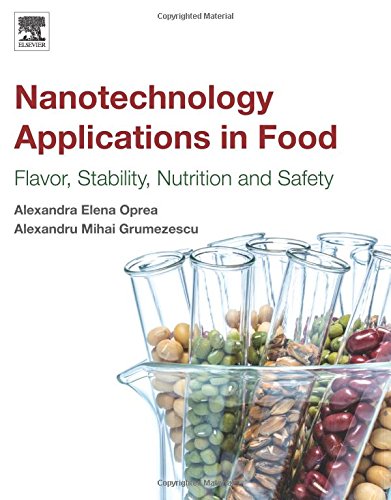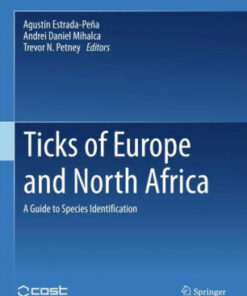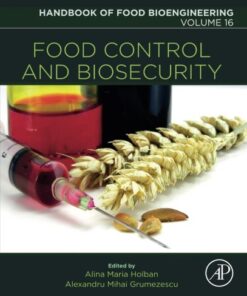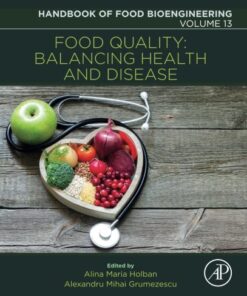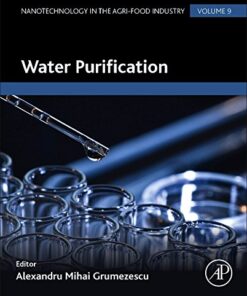(PDF) Nanotechnology Applications in Food By Alexandra Elena Oprea
$22.00
Download instantly Nanotechnology Applications in Food – Flavor, Stability, Nutrition and Safety By Alexandra Elena Oprea, Alexandru Mihai Grumezescu. It is ebook in PDF format.
ISBN-10: 012811942X ISBN-13: 9780128119426
Preview
This is the PDF eBook version for Nanotechnology Applications in Food – Flavor, Stability, Nutrition and Safety By Alexandra Elena Oprea, Alexandru Mihai Grumezescu
Table of Contents
Foreword
Preface
Chapter 1. A Key for the Future of the Flavors in Food Industry: Nanoencapsulation and Microencapsulation
1. Introduction
2. Importance of Flavors in the Food Industry and in the Global Market
3. Encapsulation in the Food Industry
4. Encapsulation of Flavors
5. Conclusions
Chapter 2. Nanotechnology in Bioactive Food Ingredients: Its Pharmaceutical and Biomedical Approaches
1. Introduction
2. Commonly Used Bioactive Food Ingredient
3. Bioactive Food Ingredient and Nanotechnology
4. Potential Advantages of Nanotechnology for Delivery of Bioactive Food Ingredient
5. Different Nanocarriers for Delivery of Bioactive Food Ingredient
6. Preparation Techniques of Bioactive Food Ingredient Into Nanocarriers
7. Release Mechanism of Bioactive Compound Form Nanocarriers
8. Potential Bioavailability Enhancement of Bioactive Compounds
9. Regulations and Safety for Nanotechnology in Delivery of Bioactive Food Ingredient
10. Conclusions
Chapter 3. Scope of Nanotechnology in Nutraceuticals
1. Introduction
2. Nutraceuticals
3. Commonly Used Nanoformulations for the Delivery of Nutraceuticals or Making Nanocarriers
4. Characterization of Nano-Nutraceuticals
5. Bioavailability
6. Nutraceutical-Based Nanocarrier and Applications
7. Disadvantages
8. Conclusions
Chapter 4. Strategic Design of Delivery Systems for Nutraceuticals
1. Introduction
2. Nutraceuticals
3. Design of Delivery Vehicles for Nutraceuticals
4. Conclusions
Chapter 5. Nanoemulsions and Their Stability for Enhancing Functional Properties of Food Ingredients
1. Introduction
2. Components and Formation of Nanoemulsions
3. Emulsifiers and Their Roles in Emulsification
4. Stability of Nanoemulsions
5. Applications of Nanoemulsions in Food Industries
6. Conclusions
Chapter 6. Nanoemulsions: A New Approach for Enhancing Phytonutrient Efficacy
1. Introduction
2. Nanotechnology
3. Nutraceuticals/Phytonutrients
4. Nanoparticulate Delivery Systems for Nutraceuticals
5. Nanoemulsions for Enhancing Efficacy of Nutraceuticals/Phytonutrients
6. Conclusions
Chapter 7. Technological Aspects of Nanoemulsions and Their Applications in the Food Sector
1. Introduction
2. Composition of Nanoemulsion
3. Formation of Nanoemulsion
4. Synthesis Methods of Nanoemulsions
5. Properties of Nanoemulsions
6. Characterization Techniques for Nanoemulsions
7. Application of Nanoemulsions in Food Industries
8. Nanoemulsion-Based Encapsulation and Delivery Systems
9. Nanoemulsion-Based Coatings/Films
10. Antimicrobial Nanoemulsions
11. Toxicology and Risk Assessment
12. Conclusions
Chapter 8. Polyhydroxyalkanoates in the Food Packaging Industry
1. Introduction
2. Biosynthesis of PHAs
3. Commercial Growth of PHAs
4. Properties of PHAs
5. PHA Blends/Composites
6. PHA Nanocomposites
7. PHAs for Paper Coating
8. PHA-Based Multilayer Films
9. PHA-Based Active Food Packaging
10. Examples of PHA Uses in Food Packaging
11. Conclusions
12. Future Prospects
Chapter 9. Nano-delivery Systems for Nutraceutical Application
1. Introduction
2. Bioactive Food Components for Encapsulation
3. Strategy for Enhancing Oral Bioavailability of Nutraceutical
4. Engineered Nanoparticle-Based Delivery System
5. Evaluating Oral Bioavailability of Nutraceutical
6. Conclusions
Chapter 10. Nanoemulsification Technology in Improving Bioavailability of Lipophilic Functional Food-Grade Ingredients and Quality of Food Products
1. Introduction
2. Effects of Food Matrix Components on Bioavailability
3. Bioavailability and Food Quality
4. Biological Fate and Toxicity Concerns
5. Conclusions
Chapter 11. Nanoantimicrobials in Food Industry
1. Introduction
2. Nanoantimicrobial Agents
3. Food Antimicrobial Nanocarriers
4. Application of Nanoantimicrobials in Foods
5. Conclusions
Chapter 12. Nanotechnology in Microbial Food Safety
1. Introduction
2. Nanotechnology Applications in Safe Food Processing
3. Applications of Nanotechnology in Food Packaging
4. Use of Nanotechnology and Nanosensors to Detect Food Borne Pathogens
5. Safety Issues of Nanotechnology
6. Conclusions
Chapter 13. Recent Advances in Molecular Techniques for the Diagnosis of Foodborne Diseases
1. Introduction
2. Food Pathogens
3. Sectors Demanding Food Pathogen Detection and Control
4. Different Methods of Food Pathogen Detection
5. Advanced Molecular Techniques for Food Pathogen Detection
6. Biosensors
7. Commercialization of Biosensors
8. Future Perspectives
9. Conclusions
Chapter 14. Intelligent Systems in the Food Packaging Industry: Contaminant Sensors and Security/Anticounterfeiting Devices
1. Introduction
2. The Current Status of Nanotechnology in the World
3. Nanotechnology Applications in the World
4. Intelligent Systems in the Food Packaging Industry: Security/Anticounterfeiting Devices and Contaminant Sensors
5. Conclusions
Chapter 15. Nanosensors for the Detection of Food Contaminants
1. Introduction
2. Contaminants in Food
3. Naturally Occurring Toxicants
4. Foodborne Pathogenic Bacteria
5. Improper Use of Agrochemicals
6. Industrial and Environmental Pollutants
7. Food Additives Over Permitted Levels
8. Emerging Chemical Hazards
9. Conclusions
Chapter 16. Nano Devices for Contaminant Detection
1. Introduction
2. Contaminants in Food Industry
3. Sensors and Sensing
4. Applications of Nanotechnology in Contaminant Sensors for Food Industry
5. Examples of Sensors for Contaminant Detection
6. Future Prospects
Chapter 17. Impact of Bacterial Nanocellulose on the Rheological and Textural Characteristics of Low-Lipid Meat Emulsions
1. Introduction
2. Case Study
3. Conclusions
Chapter 18. Bionanocomposites for Food Packaging Applications
1. Introduction
2. Bionanocomposites
3. Mechanical and Barrier Properties
4. Biodegradation
5. Antimicrobial Properties
6. Food Packaging Application
7. Safety Consideration
8. Conclusion
Chapter 19. Plant Stress Signaling Through Corresponding Nanobiotechnology
1. Introduction
2. Two Technologies: Common Objectives
3. Genomic Technology in Elucidation of plant Stress Adaptation
4. Nanoparticles in Potential Candidate Genes Targeting and Regulation
5. Conclusions and Outlook
Index
